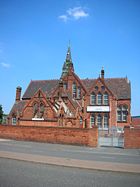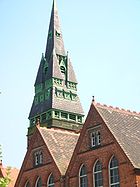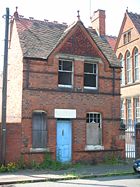
Icknield Street School
Encyclopedia



Hockley, Birmingham
Hockley is a central inner-city district in the city of Birmingham, England. It lies about one mile north-west of the city centre, and is served by the Jewellery Quarter station...
Flyover, north of the Jewellery Quarter
Jewellery Quarter
The Jewellery Quarter is an area of Birmingham City Centre, England, situated in the south of the Hockley area. It is covered by the Ladywood district. There is a population of around 3,000 people in a area....
, Birmingham
Birmingham
Birmingham is a city and metropolitan borough in the West Midlands of England. It is the most populous British city outside the capital London, with a population of 1,036,900 , and lies at the heart of the West Midlands conurbation, the second most populous urban area in the United Kingdom with a...
, England
England
England is a country that is part of the United Kingdom. It shares land borders with Scotland to the north and Wales to the west; the Irish Sea is to the north west, the Celtic Sea to the south west, with the North Sea to the east and the English Channel to the south separating it from continental...
, is a good example of a Birmingham board school.
Designed in 1883 by J.H. Chamberlain
John Henry Chamberlain
John Henry Chamberlain , generally known professionally as J H Chamberlain, was a nineteenth century English architect....
of Martin & Chamberlain
Martin & Chamberlain
John Henry Chamberlain, William Martin, and Frederick Martin were architects in Victorian Birmingham, England. Their names are attributed singly or pairs to many red brick and terracotta buildings, particularly 41 of the forty-odd Birmingham board schools made necessary by the Elementary Education...
, the main architects for the Birmingham School Board, it has been St Chad's Roman Catholic Annexe and is now an Ashram
Ashram
Traditionally, an ashram is a spiritual hermitage. Additionally, today the term ashram often denotes a locus of Indian cultural activity such as yoga, music study or religious instruction, the moral equivalent of a studio or dojo....
Centre. Standard VII classes for girls began in 1885. However, these classes closed in 1898 at the opening of the George Dixon Higher Grade Board School. In 1886, it was expanded and again so in 1894. It converted into a modern secondary school in 1945 and by 1960, it had 950 pupils.
The Chamberlain schools were designed for hygiene, light, fresh air and beauty. Typically in red brick and terracotta, gabled, with steep roofs, free planning and towered to provide ventilation. The tower was typically placed over the staircase to draw air through the school. There were terracotta plaques, glazed tiles, ornamental ironwork, tall windows, and stained glass. The arched roof-supporting ironwork of this school was visible when the roof was missing following a fire. The roof has since been repaired.
It is a Grade II* listed building. The headmaster's house (303 Icknield Street), on the site, is separately Grade II* listed. Both are on the English Heritage Buildings at Risk Register.
Sources
- John Ruskin and Victorian Architecture, Michael W Brooks, 1989
- A History of the County of Warwick: Volume 7: The City of Birmingham, 1964

